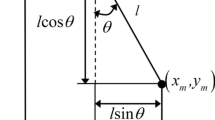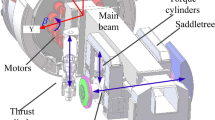Abstract
Immersed tunnel is an important part of the Hong Kong–Zhuhai–Macao Bridge (HZMB) project. In immersed tunnel floating, translation which includes straight and transverse movements is the main working mode. To decide the magnitude and direction of the towing force for each tug, a particle swarm-based translation control method is presented for non-power immersed tunnel element. A sort of linear weighted logarithmic function is exploited to avoid weak subgoals. In simulation, the particle swarm-based control method is evaluated and compared with traditional empirical method in the case of the HZMB project. Simulation results show that the presented method delivers performance improvement in terms of the enhanced surplus towing force.
Similar content being viewed by others
References
Chen, K.Q., Peng, S., Wu, W.G., Li, T.Q. and Xiong, A.K., 2012. Model test of immersed tunnel element in towing tank in winds, waves and currents, Proceedings of the Twenty-second International Offshore and Polar Engineering Conference, ISOPE, Rhodes, Greece, pp. 831–836.
China Classification Society, 2011. Guidelines for Towage at Sea, China Classification Society, Beijing, http://www.ccs.org.cn/ccswz/ font/fontAction!article.do?articleId=ff80808137de736a0137e39c40 39000b [2012-06-27]. (in Chinese)
Clerc, M., 2006. Particle Swarm Optimization, Hermes Science Publications, London.
Couce, L.C., Couce, J.C.C. and Formoso, J.A.F., 2015. Operation and handling in escort tugboat manoeuvres with the aid of automatic towing winch systems, The Journal of Navigation, 68(1), 71–88.
Fitriadhy, A., Yasukawa, H. and Maimun, A., 2015. Theoretical and experimental analysis of a slack towline motion on tug-towed ship during turning, Ocean Engineering, 99, 95–106.
Hillier, F.S. and Lieberman, G.J., 2014. Introduction to Operations Research, 10th ed., London, McGraw-Hill Science.
Kennedy, J. and Eberhart, R., 1995. Particle swarm optimization, Proceedings of IEEE International Conference on Neural Networks, IEEE, Perth, WA, Australia, pp. 39–43.
Kennedy, J. and Eberhart, R.C., 2001. Swarm Intelligence, Morgan Kaufmann Publishers, San Francisco.
Kishimoto, T. and Kijima, K., 2001. The manoeuvring characteristics on tug-towed ship systems, in: Katebi, R. (ed.), IFAC Conference on Control Applications in Marine Systems, University of Strathclyde, Glasgow, Scotland, pp. 173–178.
Nonaka, K., Nimura, T., Haraguchi, T. and Ueno, M., 1996. Measurements of stern flow field of a ship in oblique towing motion, International Conference on Marine Simulation and Manoeuvrability, Copenhagen, Denmark, pp. 389–398.
Shen, P.G., 2011. Estimation of towing resistance, Marine Technology, (5), 9–12. (in Chinese)
Shi, Y. and Eberhart, R., 1998. A modified particle swarm optimizer, Proceedings of 1998 IEEE International Conference on Evolutionary Computation, World Congress on Computational Intelligence, IEEE, Anchorage, pp. 69–73.
Varela, J.M. and Soares, C.G., 2013. A high level architecture framework for real-time simulation of ship towing operations in virtual environments, Proceedings of the 15th International Congress of the International Maritime Association of the Mediterranean (IMAM), CRC Press, Coruña, Spain, pp. 135–146.
Wu, R.D., Ying, Z.Q., Wang, Z. and Su, L.W., 2013. Model test for hydrodynamic parameters of immersed tube tunnel in static water, Applied Mechanics and Materials, 477-478, 754–758.
Xiao, L.F., Yang, J.M. and Li, R.P., 2010. Experimental study on mooring. towing and installing of immersed tunnel caissons, Journal of Shanghai Jiaotong University (Science), 15(1), 103–107.
Author information
Authors and Affiliations
Corresponding author
Additional information
Foundation item: This work was financially supported by the Ministry of Education of Humanities and Social Science Project (Grant Nos. 15YJC630145 and 15YJC630059), and the Natural Science Foundation of Shanghai Science and Technology Committee (Grant No. 15ZR1420200).
Rights and permissions
About this article
Cite this article
Li, Jj., Yang, Xj., Xiao, Yj. et al. Particle Swarm-Based Translation Control for Immersed Tunnel Element in the Hong Kong–Zhuhai–Macao Bridge Project. China Ocean Eng 32, 32–40 (2018). https://doi.org/10.1007/s13344-018-0004-2
Received:
Revised:
Accepted:
Published:
Issue Date:
DOI: https://doi.org/10.1007/s13344-018-0004-2




